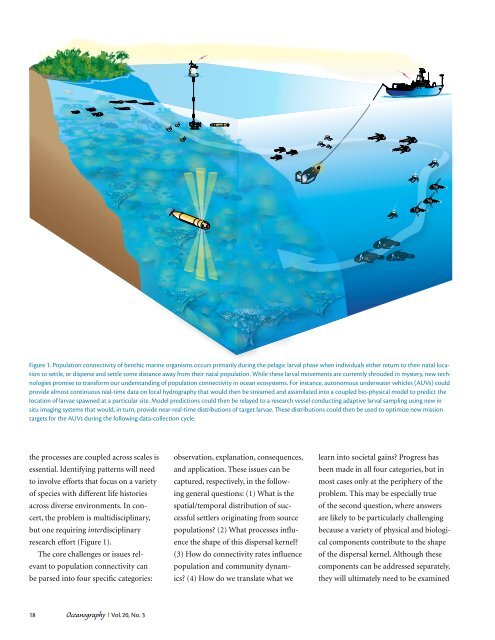Population Connectivity in Marine Systems
Population Connectivity in Marine Systems
Population Connectivity in Marine Systems
You also want an ePaper? Increase the reach of your titles
YUMPU automatically turns print PDFs into web optimized ePapers that Google loves.
Figure 1. <strong>Population</strong> connectivity of benthic mar<strong>in</strong>e organisms occurs primarily dur<strong>in</strong>g the pelagic larval phase when <strong>in</strong>dividuals either return to their natal location<br />
to settle, or disperse and settle some distance away from their natal population. while these larval movements are currently shrouded <strong>in</strong> mystery, new technologies<br />
promise to transform our understand<strong>in</strong>g of population connectivity <strong>in</strong> ocean ecosystems. For <strong>in</strong>stance, autonomous underwater vehicles (AuVs) could<br />
provide almost cont<strong>in</strong>uous real-time data on local hydrography that would then be streamed and assimilated <strong>in</strong>to a coupled bio-physical model to predict the<br />
location of larvae spawned at a particular site. Model predictions could then be relayed to a research vessel conduct<strong>in</strong>g adaptive larval sampl<strong>in</strong>g us<strong>in</strong>g new <strong>in</strong><br />
situ imag<strong>in</strong>g systems that would, <strong>in</strong> turn, provide near-real-time distributions of target larvae. These distributions could then be used to optimize new mission<br />
targets for the AuVs dur<strong>in</strong>g the follow<strong>in</strong>g data-collection cycle.<br />
the processes are coupled across scales is<br />
essential. Identify<strong>in</strong>g patterns will need<br />
to <strong>in</strong>volve efforts that focus on a variety<br />
of species with different life histories<br />
across diverse environments. In con-<br />
cert, the problem is multidiscipl<strong>in</strong>ary,<br />
but one requir<strong>in</strong>g <strong>in</strong>terdiscipl<strong>in</strong>ary<br />
research effort (Figure 1).<br />
18<br />
The core challenges or issues rel-<br />
evant to population connectivity can<br />
be parsed <strong>in</strong>to four specific categories:<br />
Oceanography Vol. 20, No. 3<br />
observation, explanation, consequences,<br />
and application. These issues can be<br />
captured, respectively, <strong>in</strong> the follow-<br />
<strong>in</strong>g general questions: (1) What is the<br />
spatial/temporal distribution of suc-<br />
cessful settlers orig<strong>in</strong>at<strong>in</strong>g from source<br />
populations? (2) What processes <strong>in</strong>flu-<br />
ence the shape of this dispersal kernel?<br />
(3) How do connectivity rates <strong>in</strong>fluence<br />
population and community dynam-<br />
ics? (4) How do we translate what we<br />
learn <strong>in</strong>to societal ga<strong>in</strong>s? Progress has<br />
been made <strong>in</strong> all four categories, but <strong>in</strong><br />
most cases only at the periphery of the<br />
problem. This may be especially true<br />
of the second question, where answers<br />
are likely to be particularly challeng<strong>in</strong>g<br />
because a variety of physical and biologi-<br />
cal components contribute to the shape<br />
of the dispersal kernel. Although these<br />
components can be addressed separately,<br />
they will ultimately need to be exam<strong>in</strong>ed<br />
OCEANUS
















